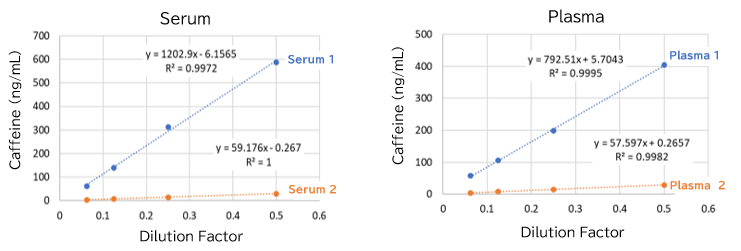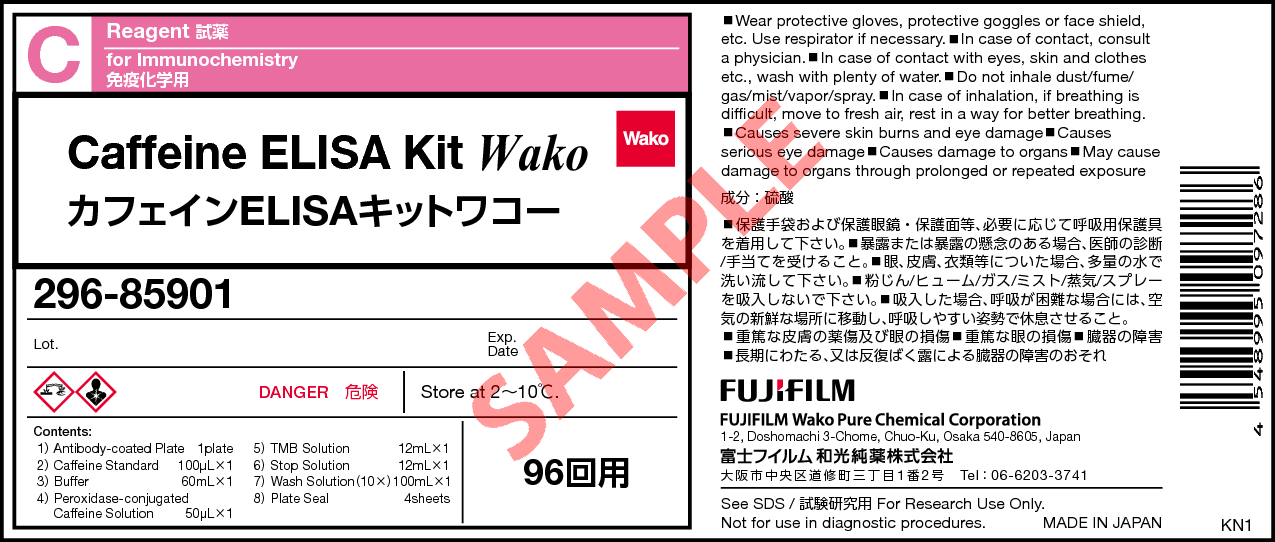Caffeine ELISA Kit Wako
- for Immunochemistry
- Manufacturer :
- FUJIFILM Wako Pure Chemical Corporation
- Storage Condition :
- Keep at 2-10 degrees C.
- GHS :
-
- Structural Formula
- Label
- Packing
- SDS
|
Comparison
|
Product Number
|
Package Size
|
Price
|
Inventory
|
|
|---|---|---|---|---|---|
|
|
|
96Tests
|
|
In stock in Japan |
Please check here for notes on products and prices.
Document
Kit component
96 tests
| Antibody-coated Plate | 1 plate |
|---|---|
| Caffeine Standard | 100 μL |
| Buffer | 60 mL |
| Peroxidase-conjugated Caffeine Solution | 50 μL |
| TMB Solution | 12 mL |
| Stop Solution | 12 mL |
| Wash Solution (10x) | 100 mL |
| Plate Seal | 4 seals |
Product Overview
Caffeine is a type of alkaloid found in coffee beans and tea leaves. It induces wakefulness and has an excitatory effect through the competitive inhibition of adenosine receptors. Caffeine is also known to have various physiological effects, including vasoconstrictive, cardiotonic, and diuretic effects, as well as promoting gastric secretion. Reports have shown that blood caffeine can be a useful biomarker for Parkinson's disease,1) and that caffeine has protective effects against Parkinson's disease.2) Therefore, it is attracting attention in the field of neurological and psychiatric disorders.
Caffeine is mainly measured by LC-MS/MS or HPLC, but the assay of caffeine used to include the need for expensive analytical equipment and complicated pretreatment. Fujifilm Wako has developed an ELISA kit that can measure the concentration of caffeine in human saliva, serum or plasma and mouse/rat serum or plasma.
Features
- Not need for expensive analytical equipment like LC-MS/MS and HPLC
- Easy-to-use pretreatment
- Can be used to measure caffeine in human saliva, serum or plasma and mouse/rat serum or plasma.
Assay Principle
This kit is based on a competitive assay, and absorbance intensity decreases as the amount of caffeine in the sample increases.
Kit Performance
| Calibration curve range | 0.244 - 1,000 ng/mL |
|---|---|
| Assay target | Caffeine |
| Analysis sample | Human saliva/serum/plasma (EDTA/heparin) Mouse serum/plasma Rat serum/plasma |
| Sample volume | 55 μL (2-fold dilution, duplicate) |
| Measurement duration | Approx. 2 hours 20 minutes |
| Detection method | Chromogenic (Primary wavelength 450 nm / reference wavelength 620 nm) |
Example of Calibration Curve
Data
Spiked recovery test
Human
| Amount spiked (ng/mL) |
Measured value (ng/mL) |
Recovery volume (ng/mL) |
Recovery rate (%) |
|
|---|---|---|---|---|
| Saliva 1 | 0 | 11.3 | - | - |
| 10 | 21.1 | 9.80 | 98.0 | |
| 50 | 64.7 | 53.4 | 107 | |
| 250 | 268 | 257 | 103 | |
| Average | 103 | |||
| Saliva 2 | 0 | 3.15 | - | - |
| 10 | 13.8 | 10.7 | 107 | |
| 50 | 53.0 | 49.9 | 99.8 | |
| 250 | 276 | 273 | 109 | |
| Average | 105 | |||
| Saliva 3 | 0 | 7.79 | - | - |
| 10 | 18.2 | 10.4 | 104 | |
| 50 | 58.3 | 50.5 | 101 | |
| 250 | 267 | 259 | 104 | |
| Average | 103 | |||
| Serum | 0.00 | 1.31 | - | - |
| 1.00 | 2.33 | 1.02 | 102 | |
| 50.0 | 49.9 | 48.6 | 97.2 | |
| 300 | 295 | 294 | 98.0 | |
| Average | 99.1 | |||
| Plasma (EDTA) |
0.00 | 2.11 | - | - |
| 1.00 | 3.15 | 1.04 | 104 | |
| 50.0 | 45.5 | 43.4 | 86.8 | |
| 300 | 289 | 287 | 95.7 | |
| Average | 95.5 | |||
| Plasma (Heparin) |
0.00 | 3.21 | - | - |
| 1.00 | 4.32 | 1.11 | 111 | |
| 50.0 | 54.9 | 51.7 | 103 | |
| 300 | 312 | 309 | 103 | |
| Average | 106 | |||
Mouse
| Amount spiked (ng/mL) |
Measured value (ng/mL) |
Recovery volume (ng/mL) |
Recovery rate (%) |
|
|---|---|---|---|---|
| Serum | 0.00 | 9.72 | - | - |
| 1.00 | 10.7 | 0.980 | 98.0 | |
| 50.0 | 62.6 | 52.9 | 106 | |
| 300 | 314 | 304 | 101 | |
| Average | 102 | |||
| Plasma | 0.00 | 8.88 | - | - |
| 1.00 | 9.87 | 0.990 | 99.0 | |
| 50.0 | 58.3 | 49.4 | 98.8 | |
| 300 | 317 | 308 | 103 | |
| Average | 100 | |||
Rat
| Amount spiked (ng/mL) |
Measured value (ng/mL) |
Recovery volume (ng/mL) |
Recovery rate (%) |
|
|---|---|---|---|---|
| Serum | 0.00 | 17.1 | - | - |
| 1.00 | 18.1 | 1.00 | 100 | |
| 50.0 | 66.1 | 49.0 | 98.0 | |
| 300 | 322 | 305 | 102 | |
| Average | 100 | |||
| Plasma | 0.00 | 4.23 | - | - |
| 1.00 | 5.22 | 0.990 | 99.0 | |
| 50.0 | 49.9 | 45.7 | 91.4 | |
| 300 | 322 | 318 | 106 | |
| Average | 98.8 | |||
Dilution linearity test
Human


Mouse

Rat

References
- Ohmichi, T. et al.: Front. Neurol., 11, 580127(2020).
Quantification of Blood Caffeine Levels in Patients With Parkinson's Disease and Multiple System Atrophy by Caffeine ELISA. - Qi, H. & Li, S.: Geriatr. Gerontol. Int., 14(2), 430(2014).
Dose–response meta‐analysis on coffee, tea and caffeine consumption with risk of Parkinson's disease.
FAQ
About sample
- How should samples be stored?
- For long-term storage of samples, store at -80°C or lower is recommended. For saliva samples, assay results did not change significantly after storage at room temperature for 6 hours, in a refrigerator for 24 hours at -20°C for 1 month or at -80°C for 6 months. (Fluctuations in room temperature were within ±10% of the temperature at hour 0.)
Please avoid repeated freeze-thaw cycles as much as possible. Based on our experience, for saliva samples collected via the passive drool method and stored at -80°C, if the number of freeze-thaw cycles is limited to no more than 5, the measured values will remain within 10% of the initial value.
- What is the recommended method of collection of saliva samples?
- The passive drool method is recommended for the collection of saliva samples. (the passive drool method requires subjects to salivate into a vial or tube.) It has been confirmed that samples collected using cotton swabs or inert polymer swabs can be used similarly to samples collected by the passive drool method. However, caution should be taken because some swab materials may absorb target analytes.
About pretreatment
- What is the pretreatment method for the samples?
- Please dilute the samples adequately. Heat treatment or similar processes are not necessary.
Human Serum/Plasma: 2-fold dilution
Human Saliva: 4-fold dilution
Mouse Serum/Plasma: 2-fold dilution
Rat Serum/Plasma: 2-fold dilution
- How should I pretreat highly viscous saliva samples?
- For highly viscous saliva samples, first freeze-thaw the sample, then centrifuge (e.g., 1,500 x g, 15 minutes, 4°C). Use the supernatant as the sample and proceed with the preprocessing (dilution) as described in the instructions provided with the kit.
Freeze-thawing will precipitate mucin, a substance that interferes with the measurement.
About the kit
- What reagents, instruments, and equipment are required for the assay using this kit?
- Purified water (distilled water)
- Tubes for dilution of standard solutions and samples
- Glassware for dilution of Wash Solution (graduated cylinders, beakers)
- Micropipettes (for 10μL disposable tips and 200 to 500 μL disposable tips)
- Continuous dispensing pipette, capable of dispensing 100 μL continuously (preferred if available)
- Paper towels or other absorbent material (to remove liquid left on the plate after washing)
- Vortex-type mixer
- Microplate shaker (range approx. 600 to 800 rpm)
- Automatic washer for 96-well plate (if available) or washing bottle
- Microplate reader for 96-well plates (for absorbance measurement)
- Software for data processing
- What type of plate shaker should be used?
- A capacity to shake the ELISA plates at about 500 rpm is required.
- Is it possible to purchase the antibody provided in this kit?
- This antibody are not sold separately.
- Can I divide plates?
- Since the plate in this kit are separable and each row (8 wells) is detachable, divided use of the kit is possible.
Overview / Applications
Property
Manufacturer Information
Alias
For research use or further manufacturing use only. Not for use in diagnostic procedures.
Product content may differ from the actual image due to minor specification changes etc.
If the revision of product standards and packaging standards has been made, there is a case where the actual product specifications and images are different.
The prices are list prices in Japan.Please contact your local distributor for your retail price in your region.







